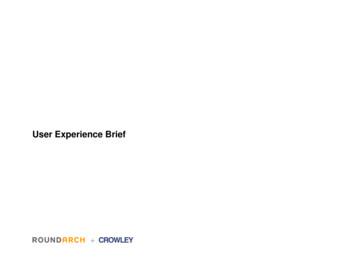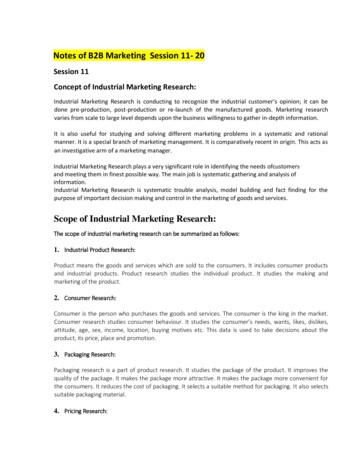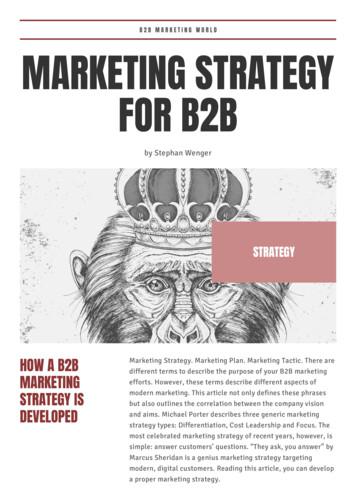How To Write A B2B Marketing Plan
Circle Research White Paper B2B Market SegmentationB2B MarketSegmentationIN SUMMARYThis paper on B2B market segmentation: Outlines the different approaches to segmentation inB2B environments Provides a step-by-step guide to adopting eachapproach Looks at how to effectively implement and action asegmentation model Provides links to B2B segmentation case studies
Circle Research White Paper: B2B Market SegmentationExecutiveSummaryThe target market for any B2B product or service is not one homogeneous mass.Rather, it can usually be divided into several distinct groups based on who theyare, how they behave, what they want or what they think.The most common approach to segmentation in B2B markets is feature based.Here the target market is divided into groups based on ‘firmographics’ such ascompany size, location or activity. This approach may also segment the marketaccording to the nature of relationship or product usage characteristics.To segment based on features follow six steps:1. U nderstand what features of a customer are relevant, i.e. will impact yourproposition for or approach to the segment2. G et a database of all your customers and record the relevant features nextto each3. Analyse your profiled customer base to identify the major groups which exist4. R esearch competitors and speak to those receiving new business enquiries toadditionally identify segments not currently in your customer base92%5. P rioritise segments by mapping on sales and profit data from existingcustomers and accessing third party statistics on the structure of thebusiness populationof B2B marketers segmenttheir target market16. I dentify which segments are likely to need a unique approach anddetail how your proposition and messaging will reflect thisA feature based approach is useful, but it’s far more powerful to segmentaccording to customer behaviours, needs and attitudes. This deeper levelof understanding lets you precisely tailor your offer and messaging so thatyou’re a perfect fit and the natural choice.Use a four stage process to adopt this approach:1. B egin by holding workshops with key customer facing staff to get theirperspective on how customers differ2. T hen arrange a series of focus groups or in-depth interviews which representa diverse mix of customers. These sessions will provide a vehicle to explorebehaviours, needs and attitudes in detail3. N ext explore these areas in a more structured manner through a large scalequantitative survey. This refines the model by including a wider range ofcustomers, allows each segment to be sized and most importantly it enablessegments to be statistically derived4. T hen apply a Cluster Analysis. This statistic sifts through the data to identifygroups of people answering questions in a similar way to each other butdistinctly different to other groups. In doing so it accurately reveals and profilesthe segmentsThis approach is a very different way of viewing customers for many and can behard to grasp as it’s ‘softer’ than feature based models. So there’s a tendency forcolleagues to intellectually accept the new segmentation, but eventually revert totheir old ways. The trick to overcoming this tendency is to develop two plans – aninternal communications plan and an activation plan.1. Source: B2B Barometer2
Circle Research White Paper: B2B Market SegmentationWhy SegmentRecently I was invited to join The Network of Aspiring Woman, BirminghamGroup. I was tempted. After all, “it’s where networking feels like a party”. However,although I regularly attend business networking events I declined for two reasons. Ilive in London. I’m a man.Clearly the Network’s execution fell short, but their strategy is smart. It’s smartbecause it recognises that the target market for any B2B product or service is notone homogeneous mass. Rather, the target market can usually be divided intoseveral distinct groups based on:1. Who they are - company features2. What they do - buying or usage behaviours3. What they want - needs, preferences and desired relationship4. What they think - attitudesBuying or eatures: Size Sector LocationSegments must be: Meaningful Distinct Sizeable Identifiable in ‘real-life’Needs, preferences ordesired relationshipSo the market for business networking events could be viewed as one market.However, this makes it very hard to develop an appealing event because noteveryone wants the same thing. For example, some want a ‘party atmosphere’ butothers want a more serious forum.So whether you’re in the networking business or any other B2B business, asegmented approach will make your marketing much more effective: A niche focus can be used as a solid basis for competitive differentiation roducts can be matched to (or developed for) the specific needs of eachPsegment Marketing messages (and channels) can be tailored to resonate with them Lists of target customers can be boughtThe result is much higher ROI on any marketing activity because it tends to hithome first time. Sounds good, huh? Before we take a look at how you can adopta segmented approach for your business, let’s tighten up the definition of what asegment actually is.3
Circle Research White Paper: B2B Market SegmentationWhen asegment isn’ta segmentAny market can be segmented on any basis. If you wanted to, you could segmentyour customers into groups based on the number of syllables in their companyname. You wouldn’t of course, but it illustrates the point that segments need tomeet certain criteria. They need to be: Meaningful – grouped on dimensions that influence how you’ll approach them Distinct – each segment needs to be clearly different to others Sizeable – each segment needs to be large enough to justify its existence I dentifiable – unless customers can be placed into a segment in ‘real life’, theexercise is uselessIf your background is in B2C marketing then it’s also important to recognise thatB2B segmentation differs from B2C segmentation in several important ways: here are usually fewer segments because B2B markets have far fewer buyersTand these buyers tend to have similar requirements. This means there’s lessroom for diversity so a typical B2B segmentation will usually see four or fivesegments emerge 2B markets tend to operate according to the 80/20 rule – 80% of revenue isBgenerated by just 20% of customers. This means that a small number of verylarge customers should sometimes be viewed as individual segments in theirown right. This is much less likely to be the case in consumer markets he points above suggest that B2B segmentations are less complex, but theyTactually bring their own complexities. It’s sometimes hard to determine exactlywhat is being placed in a segment – an individual buyer, the buying team or thecompany they work for? And as B2B products themselves are often complex,teasing out the defining features of a segment can be equally complex 2B segments tend to be based on ‘rational’ dimensions such as buying criteriaBrather than ‘emotional’ dimensions such as self-expression as is commonplacein consumer markets 2B markets tend to move at a slower pace than B2C markets which meansBthat segmentation models tend to remain accurate over the years, whereas inconsumer contexts they can date quite quicklyAnd finally, remember that no segmentation model is perfect: here will be grey areas between segments where people display characteristicsTfrom both Even within a segment, some cases will be more extreme examples than others ot everybody can be categorised – some are just seemingly random or a lawNunto themselves4
Circle Research White Paper: B2B Market SegmentationWithin a segment, peopledisplay traits to differing degreesNot everybody can becategorised into a segment‘Grey areas’ exist where people displaycharacteristics from both segmentsRight, now let’s get to it!Feature basedsegmentationThe most common approach to segmentation in B2B markets is feature based. Herethe target market is usually divided into groups based on ‘firmographics’ such as: Company size (either in terms of turnover or number of employees) Company location (country and/or region) Company activity or industry sectorFeature based segmentation may also segment the market according to thenature of the relationship. For example, existing customers may be grouped intocategories based on value or frequency of purchase.The major failing of this approach is that it doesn’t recognise that needs differeven within feature based segments. Admittedly, companies of similar sizes or insimilar sectors do often share similar requirements, but there are usually importantdifferences between them. For example, many technology companies segmenttheir market into SMB (small and medium sized businesses), Enterprise (largerbusinesses) and Public Sector. Let’s take one of these segments to illustrate thepoint. SMBs, especially in relation to technology, differ wildly in their behaviours,attitudes and needs. Some are luddites; others are at the cutting edge. Somehave a dedicated IT function; others rely on third party expertise. Some view IT asmission critical; others could temporarily survive without. I could go on, but you getthe point. So to treat all SMB customers as the same misses a big opportunity.That said there are some compelling benefits to adopting a feature basedsegmentation: It does reflect differing customer needs to some degree I t’s easy to implement – identifying segments and assigning customers isrelatively straightforward I t’s actionable – people ‘get it’, lists of target customers can be bought andmarketing channels identified (e.g. industry trade media)5
Circle Research White Paper: B2B Market SegmentationFor these reasons, feature based segmentation is heavily used in B2B markets.You can do so by following five steps:1. U nderstand what features of a customer are relevant, i.e. the features which willimpact how you should approach them. Often talking with those on the front line(sales teams, customer service, etc.) provides good guidance in this respect,and usually company size and sector emerge as the two primary features81%of B2B marketersuse a feature basedsegmentation22. G et a database of all your customers (easier said than done perhaps!) andrecord the relevant features next to each. When doing so use clear cutcategorisations so that you’re able to analyse the database. You can createthese categories however you wish, but commonly used size bandingsare sole traders, 1 – 9 employees (also known as micro businesses),10 – 49 employees (small businesses), 50 – 249 employees (mediumbusinesses) and 250 employees (large businesses). Industry sectorsare typically categorised according to SIC codes – a series of four digitcodes many government statistical bodies use to classify industries.The benefit of adopting one of these widely used methods is that whenlooking to buy in prospect data or size the market using third partystatistics, your segments can be directly matched to those of most dataproviders3. W ith a profiled database in hand, analyse your customer base to identify themajor groups which exist. But don’t stop here. It’s quite possible that thereare segments in the market who are not currently your customers. To identifythese take two steps. First, speak to those receiving new business enquiriesto understand if there are prospects whose ‘type’ is under-represented in yourcustomer base. Second, research competitors to see how they segment theirmarket (often their website will reveal this or if they are publicly listed, investorstrategy presentations can be a gold-mine of information)4. N ow that the major segments in the market have been identified you needto prioritise them. Mapping on sales and profit data from existing customersprovides good guidance in this respect. You may also find it useful to accessgovernment statistics on the structure of the business population as this canreveal the total market and segment size5. A nd lastly, identify which segments are likely to need a unique approach anddetail how your offer and messaging will reflect thisBehavioural,needs andattitudinalsegmentationA feature based approach is useful, but it’s far more powerful to segmentaccording to customer behaviours, needs and attitudes. This deeper level ofunderstanding lets you precisely tailor your offer and messaging so that you’re aperfect fit.Like all good things though, this approach is not easy. Effort needs to be investedinto fully understanding customers and developing a comprehensive segmentationmodel. The resulting segmentation also needs to be carefully implemented if it isto gain traction.It is worth the investment though, and the ideal is to develop a segmentationmodel using a four stage process:2. Source: B2B Barometer6
Circle Research White Paper: B2B Market Segmentation1. B egin by holding workshops with key customer facing staff to get theirperspective on how customers differ. Starting with this internal view will helpto design subsequent stages of the research and guide the line of questioningfollowed. These sessions should use interactive, thought-provoking exercises tocreate an initial hypothesis of how many segments there are in the market andwhat makes each one different from the next. For example, workshop delegatescould be asked to stereotype the different customer types they’ve met and actout a scene involving them2. T he internal view is a good starting point, but it’s essential that anysegmentation model is based on insights gleaned directly from the customer.Steps two and three ensure this is the case. Arrange a series of focus groupsor in-depth interviews (which depends on the situation, e.g. if customersare geographically dispersed or fierce competitors then focus groups aren’tappropriate) which represent a diverse mix of customers so that all possiblesegments will emerge. These sessions will provide a vehicle to explorebehaviours, needs and attitudes in detail. After a while you’ll begin to noticedistinct segments emerge in relation to each of these dimensions. This providesan initial segmentation model. The dimensions this model is based on willbe unique to your situation, but common factors which define different B2Bsegments include:Common Segmentation Dimensions in B2B ModelsBEHAVIOURSRange or type of products and services boughtReasons for or style of product use, e.g. buying for re-sellWay in which purchase decisions are made, e.g. consideredAttitudes to decisions, e.g. level of risk adversityATTITUDESNEEDS & PREFERENCESBusiness criticality of the product or serviceDesired relationship, e.g. partnershipEmotional attachment to industry/professionLevel of expertise and knowledgeLevel of inertia and loyaltyProduct specific functionality requirementsLevel or nature of support/customer serviceCommercial terms, e.g. price sensitivityPreferred purchase or support channels3. T he qualitative approach adopted in stage two is great for creating an initialmodel, but a more structured approach is needed to verify, size and profilesegments. So stage three does just that. It explores behaviours, needs andattitudes but this time does so in a more structured manner and with a largergroup of the target market (e.g. through rating scales). There are three reasonsfor doing so: it refines the model by including a wider range of customers, itallows each segment to be sized and profiled, and most importantly it enablessegments to be statistically derived. In this step also be sure to includequestions around their spending behaviours and marketing channel preferences.This lets you prioritise high value segments and tailor your marketing approach7
Circle Research White Paper: B2B Market SegmentationOnly38%of B2B marketersuse a needs basedsegmentation34. S tep four is the science bit. Armed with lots of data from a representativesample of customers, you need to make sense of it and reveal the segments.To do so have a statistician apply a Cluster Analysis (Cluster Analysis is actuallya family of different statistical techniques which includes our preference, theCluster Ensemble approach). In layman’s terms, Cluster Analysis sifts throughthe data to identify groups of people answering questions in a similar way toeach other but distinctly different to other groups. In doing so it accuratelyreveals the segments. And more than that. It sizes each segment by identifyingthe percentage of those interviewed falling into each group, it profiles eachsegment by overlaying firmographics and, if you’ve included sales data in theanalysis, it can even identify the most profitable segments. Overlaying thisinformation is invaluable when it comes to deciding which segments toprioritise and actually targeting them (e.g. if a priority segment is mostprevalent in a particular sector you can focus marcomms on relevanttrade publications). As well as identifying segments, Cluster Analysisalso identifies a small number of ‘magic questions’ from the survey.These questions are the most powerful in assigning someone to theright segment, so by asking them in ‘real-life’ you can quickly assign anycustomer to their segment and act accordingly. This capability comes intoits own when implementing the segmentation (see later)Now you have a clear map of your target market. The different segmentshave been revealed, their needs have been identified, they’ve been prioritisedbased on size/value and you can find them in real life as they’ve been profiledfirmographically.Implementingthe segmentationmodelThere’s one final step though. You have a carefully crafted segmentation, nowyou need to use it. This is harder than it might sound and countless segmentationexercises fall at this last hurdle.The problem is one of human nature. A behavioural, needs based or attitudinalsegmentation is a very different way of viewing customers for many. It can alsobe hard to grasp as it’s ‘softer’ when compared to feature based models. What’smore, a ‘soft’ approach like this can be harder to use on a day-to-day basis. Youmay have a proposition perfectly matched to the needs of segment X, but howcan a sales person contact them? Or if a prospective customer makes an enquiry,how does the sales person identify which attitudinal segment they are in so thatthe right ‘hot buttons’ can be pushed? So there’s a tendency for colleagues tointellectually accept the new segmentation, but revert to their old ways soon afterit’s introduced.The trick to overcoming this tendency is to develop two plans – an internalcommunications plan and an activation plan.The internal communications plan is designed to spread the new view of thecustomer throughout the organisation and ensure that each segment is fullyunderstood. Every plan is unique but it’s important to: 3. Source: B2B Barometer ring segments to life by giving them a memorable name and creating a ‘penBportrait’ describing them. Let your creativity loose here for maximum impact. Forexample, use actors to create a ‘meet the segments’ video or place life size cutouts around the office8
Circle Research White Paper: B2B Market Segmentation I nvolve all customer facing staff as they’re the ones who’ll need to usethe segmentation. ‘Involve’ is the active word here. Colleagues will betterunderstand the segments if they need to actively learn about them. Again,creativity pays dividends here. For example, role-playing exercises give aperspective on the segment which words can’t matchBut equipping colleagues with an understanding of and belief in the segments isnot enough. You need to provide them with the tools to act on the knowledge – youneed an activation plan. There are three parts to this plan:Segmentationin practice he ‘marketing’ section details how your offer and messaging strategy willTdiffer by segment. Think about their unique product needs, how they want tointeract with you, what will keep them loyal (or make you first choice if they’re aprospect) and what communication channels they prefer he ‘relationship’ section is designed for sales and account management teams.TIt provides them with easy to use tools to identify which segment a customerfalls into (see ‘magic questions’ earlier) and a ‘cheat-sheet’ outlining how theyshould tailor their approach in light of this. It also provides details of which‘firmographic’ categories each segment is most prevalent in so that target listscan be bought he ‘systems’ section contains a plan to embed a segmented view. The mostTimportant action here is to assign each customer on your CRM database toa segment as this allows marketing campaigns to be tailored. This can beachieved by asking ‘magic questions’ to all new customers and to existingcustomers whenever the next contact is made. Of course, this won’t alwaysbe practical so an alternative is to model the data. This approach begins byassigning a sample of customers to the correct segment by asking the ‘magicquestions’. It then applies statistical analysis to uncover other characteristicswhich make members of a segment identifiable and are already held in relationto all customers, e.g. most members of segment A have bought product Xand contacted customer support three times in the last six months. As thecharacteristic data is already held for all customers, it can then be used toassign them with a reasonable degree of accuracy to the right segmentSo that’s the theory. If you’d like to have a look at segmentation in action, youmight like to read these case studies from Global Blue l-blue/) and Moneycorp corp/).Sound interesting?We’d love to talk.Call David Willan on 44 (0)20 7960 3800or email him at david.willan@circle-research.com
There are usually fewer segments because B2B markets have far fewer buyers and these buyers tend to have similar requirements. This means there's less room for diversity so a typical B2B segmentation will usually see four or five segments emerge B2B markets tend to operate according to the 80/20 rule - 80% of revenue is
Cleo Jeans B2B 839 H Communion Collection (The) RC 721 Coolman Trading B2B 243 Cooper & Nelson RC 305 Copen Sportswear B2B 443 CounterattackB2B 726 H Cre Brand B2B 730 Culture Jeanswear B2B 931 D-LUX B2B 338 D’Italia RC 1315 Daniel Ellissa RC 100 H Darring VIA 1009 David X RC 609 Deals Wholesale B2B 935 & 938
B2B Marketing magazine subscription. › Annual events for B2B marketers: B2B Marketing Ignite USA and the B2B Marketing US Awards Go to b2bmarketing.net to find out more About B2B Marketing. Get in touch Alex Burton Customer care manager E: alex.burton@b2bmarketing.net T: 44 (0)20 7014 4920 B2B Marketing
Boom Boom Jeans B2B 639 Boyle Heights B2B 744 Boys Nautica B2B 425 Braveman RC 105 Brian Brothers B2B 342 H Brio Milano RC 207 Bruno Conte RC 809 Brutini NRG 645 Bryan Michaels RC 707 BTL B2B 116 Budabean B2B 335 Buffalo Jeans VIA 900 C.K.L. RC 212 C.O.D. Friendly CONCOURSE the BRANDs H NEW AT THE COBB
Base: 110 B2B online sellers Source: Q2 2015 Forrester/Internet Retailer B2B Sell-Side Online Survey 73% 44% 42% 36% 34% 24% 21% 19% 15% 30% 29% 19% 22% 20% 12% 15% 12% 23% 25% 35% 36% 45% 53% 36% B2B website Smartphone Tablet 3rd party partner B2B websites 3rd party partner B2C websites Call center/phone B2B print catalog In-person (store .
May 24, 2010 · The B2B Sales Funnel models the process of—and typical stages within—B2B sales. Unlike B2C sales, B2B sales are often characterized by collective decisions made by groups of people, as opposed to individuals. Moreover, a B2B sale rarely has an eCommerce component at its heart. Rather, B2B sales themselves are much more likely to occur offline.
B2B Marketing Session 12 , 13 and 14 B2B Marketing Strategy Process: 1. Start with customer research 2. Conduct qualitative and quantitative analysis 3. Establish key objectives and metrics 4. Develop your B2B customer journey map 5. Identify executional marketing tactics For B2B companies, the potential buyer pool is typically smaller and less .
the marketing plan. B2B MARKETING WORLD Step #1 - Define marketing aims Step #2 - Analyze the status quo Step #3 - Define your target group and buying center personas (BCP) Step #4 - Describe the customer journey. Your B2B Marketing Tactic. The 6 steps to create a marketing strategy in B2B are: The marketing aims are derived from the .
The sample size comprised n 301 marketing, insight, CX and business strategy decision makers across brands serving B2B audiences. The survey was designed, fielded and analyzed by the full service B2B market research firm, B2B International, Jan-March 2021. 62% of respondents were sourced through Merkle B2B databases; 38% through external panel.























